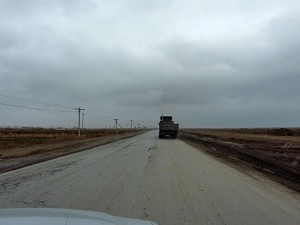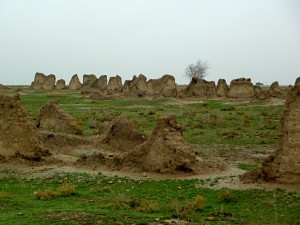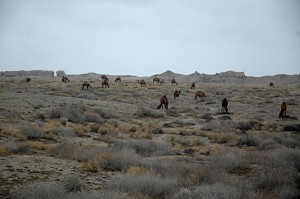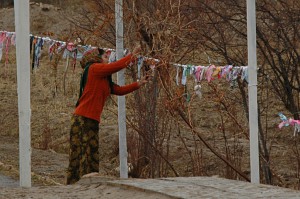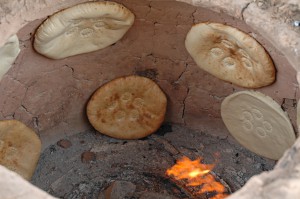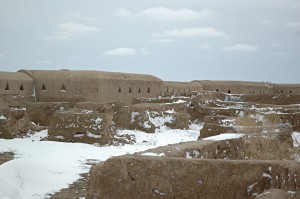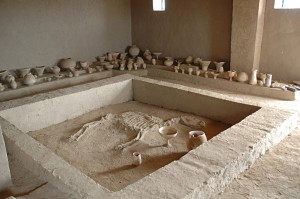After the surreal world of Ashgabat I was very curious about the looks of the rest of Turkmenistan. I was glad having chosen the car as means of transport to Mary, a very important point on the silk road.
To wake up on time the second morning in Ashgabat, to be sure to get breakfast before hitting the road, I had set my alarm clock. It was a great plan to wake up early to have breakfast, but it almost was worthless due to the local conditions. I woke up on time and left the hotel just before 8am to go to the shopping mall on the other side of the road, where there is a café and a restaurant. Unfortunately this early in the morning neither of them was open and also the Pizza Haus next door to the hotel was closed, although at least someone was present. The small shop in my hotel came to the rescue as it opened after 8 o’clock, such that I could improvise and buy some ingredients for a breakfast which I consumed in my hotel room. This whole action gave a completely new meaning to the sentence “breakast NOT included” on my travel program. Different countries, different customs…
Right at 9 o’clock Murat my driver arrived at the hotel. We immediately hit the road to spend the next 6 hours in his old BMW 525 to drive the 350 km to Mary. People kept telling me that it would take that long because of the bad shape of the road. Initially I had troubles believing that story, since the roads in Ashgabt and vicinity couldn’t be much better. But once we had been driving for the better part of an hour, I understood those statements about road quality. With my degree in communications and signal processing in particular, I would describe the road quality using a cardinal sine function with Ashgabat at the origin and the x-axis describing the distance from Ashgabat. On the first kilometers, the road quality is close to perfect followed by a very steep descent and varying quality later on.
From the car I could make same observations about Turkmen life outside of Ashgabat, beyond marble and gold. There are three trains and one direct bus from Ashgabat to Mary, the second largest city of the country, per day. The people wait desperately for a ride on the road side. Many of the locals held out their hand when we approached indicating they need a ride. Murat’s mission however was clear: bring the tourist unharmed to Mary and don’t pick anyone else up. We passed a few local and one possibly long-distance bus. The latter sported a country side stating DDR (for German Democratic Republic).
The rain of the past days had changed the towns along the main road into veritable mud-wholes. The pot-holes in the road can be counted with the same order of magnitude as the debts in some of the European countries: not to the thousands, not to the millions, but to the billions. The impression I got was the Turkmenistan would probably be a perfect fit for the stereotypes many people have of Iran. Before I left for my trip I had read that the political situation in Turkmenistan is on par with North Korea. In the meantime I can understand that comment very well. Anyone visting the country I can recommend visiting Ashgabat and the country-side to get a completer impression of what really is happening in this country.
On our drive from Ashgabat to Mary, we stopped at the ruins of Abiverd. Unfortunately there were no explanations and Murat was only driver but no guide. As far as I can tell, there is a large castle with a settlement at the side of a about the same size. As in Nisa, the buildings were built from mud-bricks and thus time has taken its toll on the constructions. But one can get a very good idea of what must have been at this place some 2000 and more years ago.
We stopped for lunch at a small restaurant near the Ogus Khan Köl, a large lake about 80 kilometers to the West of Mary. I was surprised to hear that there was supposed to be good fish, since I had this stereotype of steppe and desert in my mind. The large fish had been cut into handy pieces and was fried. Since the only tool for eating I had received was a fork, a spoon less than in Iran, I needed help in how to eat the fish. I was glad that Murat was not worried about his behavior in front of a tourist and started eating the fish by hand. Finally I had more a feeling of eating chicken instead of fish, as it was a large fish with a solid spine and grates. The fish was served with a hot sauce, bread and a small salad. The fish tasted very fresh and reminded me of some fish I had in South Africa on the coast of the Indian Ocean.
About an hour after leaving the restaurant Murat dropped me at the Margush Hotel in the center of Mary. Though the center is there were they built a few marble buildings. During the following stroll, I discovered the central bazaar, where I covertly took a few pictures. But apparently there is no reason to worry in Mary.
For dinner I had my first shashlik of Central Asia in the café of the reception lady’s uncle. This is how relations work. Fortunately I had learned from Murat at lunch, that the fork serves more for decoration than as a utensil, such that I could eat my food by using my hands only.
Breakfast was simple this time: just sit down at a table and answer the typical questions about tea or coffee and your breakfast will be served. Just before nine I went to the lobby to meet my driver Murat and hopefully Ewgenjia my guide for the day. But besides Ewgenjia, there was also Muhammad who would finally be my guide for ancient Merv. Ewgenjia was busy with the other two tourists in the hotel. I tried to get the information from Muhammad, whether it was actually possible to travel individually without a guide in Turkmenistan. His statement was that the travel agencies would not allow that, since the would get in trouble with the government. Already in Ashgabat I realized that Berdy was quite often on his mobile phone answering questions to our whereabouts to Artyk. The only way for individual travel in Turkmenistan seems to be the 5 day transit visa.
Muhammad and I sat in Murat’s car and drove for about half an hour from Mary to the ancient city of Merv. On the way we passed the brand new Hippodrome, another symbol for on of Turkmenistan’s prides: their thorough-bred horses.
Ancient Merv has seen about 4000 years of history and was the Seljuk’s captial. Thus it is no surprise that the ruins found near Mary are overwhelming in size. Sicne all buildings had been built using mud-bricks, most of what one can see today are hills, where there used to be the buildings. With a little imagination however one can guess the richness which once reigned here. Discovering all the ruins on foot take several days.
The cultures from all directions met in Merv, from the Middle East to Asia. Similar to Iran, there were different dynasties from different origins over the centuries. The came from the North, the East and the West. Additionally Merv was a centrel trading point along the silk road. So far only 10% of the ruins have been excavated, but I am pretty convinced that one could find Chinese goods among other remains.
The fortress walls one can see today date back to the Achaemenids, Alexander the Great and to the Seljuks. In this order newer and larger walls and settlements were built, standing one next to the other. In between, there are smaller fortresses and a few mausoleums, which endured the centuries and some even the attacks of Ghengis Khan. The most glorious mausoleum still standing to today is the one of Sultan Sanjar, the last king of the Seljuks and was renovated with the help of the Turkish government at the begin of this century. In front of that mausoleum I had the honor to become a photo model for a local family who wanted their picture taken with me.
The Turkmen make pilgirmage to some of the shrines in this area hoping for better life, children, and so on. Even though the pilgrimage sites are all Muslim these days, the mix in their local tradition of circling the shrines three times while praying. Since I happened to be in ancient Merv on a Friday, I came to see quite a few people visiting the shrines. At one of the shrines local families also sacrifice sheep on special occasions. The meat from the animal is then distributed to everyone present. In order to achieve this feat there is a large kitchens with several cauldrons where the meat is cocked with other ingredients. Next to the kitchen are several dining rooms, where the people sit together and eat.
After our visit of ancient Merv, we headed back in direction of Mary to have lunch in a restaurant on the way. After the shashlik the day before I tried ground meat this day. I was quite surprised to be served a meal which was identical to Cevapi on the Balkans. For me this was one sign how the cultures spread through the different kingdoms like in this case the Byzantine and the Ottoman empires. The people in Central Asia have the same roots as the Turkish, which is not only present in the culture, but also in the language.
After lunch we briefly headed to the orthodox church Pokrovskaya in Mary, before I was dropped of at the hotel for a 2 hour Friday prayer break.
Muhammad then showed me around the brand new museum in a 90-minute tour. The museum sports the typical exhibits about history, ethnography and arts. However unusual for me was the president’s hall. This hall shows the president as the hero he is by exhibiting the books he wrote and by showing photographs of heroic activities such as cooking plov in front of a yurt, being a sportsman by riding a horse, jogging on the health path in Ashgabat or playing tennis, conducting an operating a practizing dentiest, etc. I would be interested what Muhammad really thinks about this exhibit, but I didn’t want to provoke him, like I had done with Elena in Ashgabat.
During the tour through the museum I learned another few interesting facts about the country: the marble quarter in Mary has only been built very recently. The museum and the larger library sporting an observatory only opened during the past two years. All the marble buildings were built by a Turkish company.
The tour was very nice, but the weather outside was a different story. During the time in the museum it had changed from rather mild and cloudy with little rain to a full blown blizzard. The Turkmen TV station still indicated it was 7°C and cloudy, while outside the world was covered in white. Until the evening there was a little more than an inch of snow on the ground.
For dinner I went to a nearby café where I wanted to try Somsa, triangles made of dough with meat and onion fillings. Unfortunately I didn’t remember the name corretly and the Sousa which I tried to order was not available. So instead I opted for a chicken shashlik. The choice wasn’t a bad one either, the shashlik was very tasty.
Just when I finished eating two brothers entered the café and we started chatting. Despite their limited knowledge of English and my very limited knowledge of Russian, we could share a few basics. I learned they were 20 and 21 years old and originally from Uzbekistan. Their grandparents still live near Bukhara, where I planed to travel a few days later. Both of them wanted to go to Moscow in December for their studies. After our entertaining discussion a walked through light snowfall and a cold wind back to the hotel.
For Saturday an excursion to the kingdom of Margush was planned. Margus was one of the five known civilizations during the bronze age. Today the ruins lie at the edge of the Karakum desert, about 100 km from Mary. Due to changes in the bed of the river Murgab, a few centuries later, Margush became ancient Merw and modern Mary. The different settlements lie quite a few kilometers apart.The change of a river thus decided about decline of whole cultures. A phenomen which I encountered though made these changes seem strange: snow in the desert! At 9 o’clock we left the hotel in a car suitable for driving through the desert, to stop first at the bazaar to exchange some money and buy snacks, before heading North-East for about 70 km and then turning North an a sand track for another 30 km to Gönur Tepe, the settlement of Margush we were going to visit.
On this day I also realized why my organized tour was so expensive: I had three people with me for the whole day: Ruslan, the driver, Murat as passenger for emergencies and Ewgenjia as an English-speaking guide.
Just before we turned onto the sand track I had the opportunity to watch how Turkmen bread is baked traditionally. This didn’t happen in a museum or in a special tourist site, but on the road side, where the family were selling their bread. The portioned dough is marked in the center with a sort of a mortar on a pillow. The pillow is then used to press the dough at the wall of the tandoor where a small fire is burning. As soon as the bread falls from the wall, it is throughly baked. We took a few breads and tried one on the spot. Fresh bread always tasted good!
Ewgenjia made use of the drive to give me an introduction to the site of Gönur Tepe, such that we didn’t have to do this outside at -2°C. I considered especially interesting how the archeologists actually found the ruins about 40 years ago in the desert. The only written indication they had at the time was the inscriptions in the palace of Darius the Great at Persepolis. The kings at the times had their heroic acts written down for future generations.
I could discover the ruins on my own, since Ewgenjia was not very well equipped for the conditions. Since I had had all the explanations in the car, it was no problem to find the orientation and the indicated rooms. After the ruins we visited to burrial places where one could also see all the items placed in the grave with the deceased.
For me the attraction of the day besides the ruins was the drive through the dessert. During summer the challenge is not to get stuck in the sand. On Saturday however the challenge was to get well through the wet sand, the pools of water and the snow. I got the impression that Ruslan our driver was not very experienced, but luckily we had Murat sitting beside him, pointing out where to go.
Finally we also made our way back on which we passed a truck with people on the flatbed. Apparently people still picking cotton at the edge of the Karakum desert.

